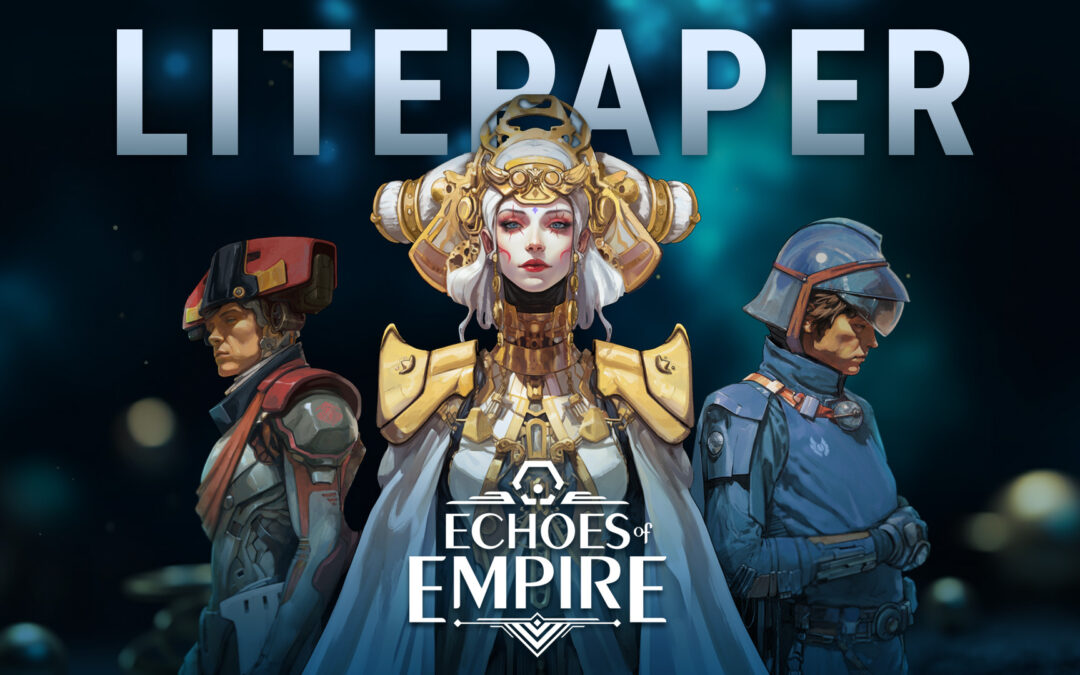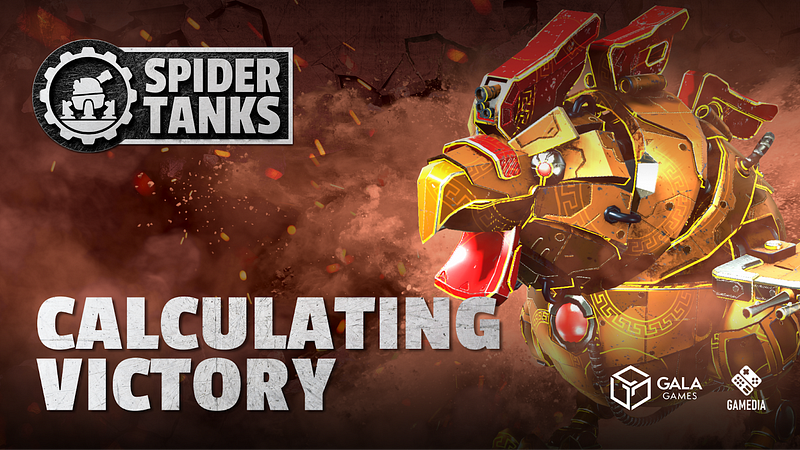
Echoes of Empire: The Litepaper
Echoes of Empire is a web3 space MMO that combines deep strategy, engaging gameplay, and a dynamic economic system of player ownership. Set in a vast universe consisting of quadrants of space, players can explore, trade, and fight to expand their influence and claim territory. This litepaper outlines the core gameplay mechanics and interactions, providing a comprehensive overview of the game’s design, mechanics, and economic plans.
Overview of Gameplay
Homebase
The core of Echoes of Empire gameplay takes place on a massive scale, larger than any simple planetary inhabitant can comprehend. Each player is the leader of a noble house or family that controls a huge Homebase space station with the capacity to explore known space, mine resources from Celestial Bodies, craft thousands of ships, and battle with enemies. Players are far too important in the grand scheme of the game’s narrative to be relegated to a single planet or habitable moon; therefore, the Echoes of Empire board is the entirety of known outer space. In fact, within the game’s Galaxy view, players and Celestial Objects are represented as tabletop gaming tokens.
Players interact with the game in either Homebase view, where ships, base buildings and blueprints are upgraded and resources are collected, or Galaxy view, where Celestial Bodies and enemy Homebases are viewable for things like harvest deployments and raids.
Gameplay
In Echoes of Empire, each player explores the sprawling remains of the crumbled Empire, whose holdings are all up for grabs. Players explore, expand, exploit, and exterminate their way to intergalactic notoriety, using technology from the 3 galactic factions (Arbeiters, Royals and Garrison) which led to the Empire’s downfall. The player’s primary role is that of curator/collector, using resources and strategy to maximize efficiency and growth.
Echoes of Empire is built around various gameplay interactions that drive the player’s experience. These interactions can be broadly classified into the following categories:
- Exploration: Through exploration, players can discover and navigate new Celestial Objects. A Celestial Object is anything marked on the Galaxy map and given a rarity.
- Combat: Players engage in strategic battles with enemy fleets to achieve strategic objectives or to protect their own assets. At launch, combat will take place only at players’ Homebases and at Celestial Objects that contain resource mines. Future updates will expand the locations where combat can take place.
- Trade: To fulfill individual needs or advance their in-game goals, each player may trade resources and assets with other players, but full trade features will not yet be available at launch.
- Progression: By advancing their character, fleet, or assets through various activities and mechanics, players can unlock new abilities and features.
- Questing: Players participate in narrative-driven missions or tasks, challenging them to achieve specific objectives and receive rewards.
- Landholding: Players may acquire and manage their own Celestial Objects via Celestial Claims in order to control resources, access services, and establish strategic presence.
- Provisioning: Various items known broadly as Featured Holdings may be obtained through transactions, crafting, or other in-game methods to build and maintain a player’s inventory.
- Management: Through resource allocation and strategic decision-making, players can optimize the performance of holdings, such as Fleets and Celestial Objects.
- Maintenance: Players must keep up their Homebases and stay competitive by maintaining the functionality and durability of their holdings. Examples are repairing and salvaging ships or managing Homebase operations.
Player Goals
The player’s primary goals are to increase their prominence and influence throughout the Celestial Objects in the various ways described below.
While elements of PvP contention exist and form strong parts of the Echoes of Empire narrative, they are not central to the player experience of upgrading and expanding one’s empire.
Economic System
The economic system consists of several key components, including resource generation and consumption, sinks and faucets, and the role of the game’s web3 elements made possible by GalaChain.
Resource Generation and Consumption
Resources are in-game (non-minted) tokens necessary for various interactions such as crafting, trade, and progression. There are 3 main resources (Ore, Vapor, Composite) that can be generated through multiple means (faucets):
- Harvesting: Players can collect resources from mines on various Celestial Objects scattered throughout the universe.
- Production: Homebases produce resources over time via the 3 upgradeable Extractor buildings. Each Extractor also has a corresponding Vault that allows a certain quantity of the designated resource to be protected against raids. In order to maximize Extractor resource production, players must regularly harvest extracted resources. Upgrading Extractors increases maximum time between claims while maintaining efficiency.
- Salvage: When a player has upgraded their Capital Ship Blueprints and unlocked higher tiers of ships, old ships may be scrapped for resources.
- Achievement: Players can acquire resources through trade or other in-game interactions such as quests. This includes the new player tutorial, in which valuable resources are awarded for upgrading Homebase buildings.
- Trade: With a future update, resources will become tradable between players, or with NPC “vendors.”
These resources can also be consumed in several ways to benefit the player experience, including (sinks):
- Crafting: Players use resources to create items such as ships
- Trade: With a future update, resources will become tradable between players, or with NPC “vendors.”
- Upkeep, Upgrades and Maintenance: Players must spend resources to upgrade and maintain their fleets, Homebases, and owned Celestial Objects.
$GALA Integration and Rewards
Echoes of Empire is powered by GalaChain.
By leveraging web3 tech, Echoes of Empire provides a transparent and secure environment for economic and social interactions. The use of minted items enables players to own in-game assets, such as Ships, Blueprints, Celestial Objects and more. These owned items can be bridged off GalaChain or traded through the in-game marketplace (in a future update).
Many owned items can be permanently upgraded on-chain, allowing active players to use both gameplay and secondary market commerce to find opportunities to increase their in-game holdings.
A designated in-game (non-minted) currency called Stardust is central to the reward structure for Echoes of Empire.
Stardust
Stardust is a special in-game token that can only be obtained by harvesting the mines on Celestial Objects that are owned by other players. When a Celestial Object is unowned, it does not produce Stardust, but if it gets claimed by an owner via a Celestial Claim Token, it will begin producing Stardust.
$GALA is earned and distributed daily from a reward pool (described in detail below) to all eligible players, and Stardust is the sole determining factor for daily $GALA distribution rewards for players.
Raiding for Stardust
Players may raid one another and steal Stardust, and a certain amount of Stardust is protected according to the Homebase level of their Command Center.
Stardust to $GALA Rewards
Each day at 2pm PT, 50% of the Stardust stored in each player’s Homebase is burned and replaced in the player’s Gala account as a $GALA claim allowance. The amount of $GALA available in this reward pool is determined by the total spent on purchases made in the Echoes of Empire store from the previous day.
The percentage of Stardust contributed to the daily burn is directly proportional to the percentage of $GALA from the reward pool that player will receive. $GALA reward tokens will build up daily as a Claim Allowance, to be claimed when the player chooses through their account.
Owners of Celestial Objects also automatically receive a portion of the Stardust generated from other players’ mining of the mines on that Celestial Object. Owners of Celestial Objects set the percentage of Stardust that will be shared with them when the mines on their Celestial Object are used by other players.
“Ownable” Items
Several types of items in Echoes of Empire can be owned by players as GalaChain minted items. This section of the Litepaper outlines the different types of ownership available to players within the game.
Credit Packs
Credits are a special in-game currency that is sometimes rewarded for achievements. Resource packs (Composite, Ore, Vapor) may be purchased in-game directly for Credits, or Credits may be spent to expedite (eliminate wait time on) upgrade and building processes.
Credit Packs are sold as expendable minted items in the Gala Games store.
Special Blueprints
Capital Ship Blueprints are upgraded in the Research Lab of a Player’s Homebase. Some special Blueprints are only available as GalaChain minted items, purchased from the Gala Games store.
Skins and Cosmetics
Players can use minted items such as Homebase Skins, Ship Skins or exclusive Avatars to create a personalized experience within the game.
Celestial Objects
Celestial Objects are in-game locations that offer resources, services, or strategic opportunities. Many Celestial Objects may be claimed for ownership by players through the use of a Celestial Claim token for the object’s corresponding sector and rarity.
Essentially, every marked location in the Galaxy view is a Celestial Object, but not every Celestial Object is owned or has the option to be claimed by an owner. For example, no Common Celestial Claim Tokens have been sold via presale, but there are many Common Celestial Objects throughout the Echoes of Empire Galaxy.
Claiming a Celestial Object
By owning a Celestial Claim Token, a player gains the ability to Claim any Celestial Object of the Claim’s specified rarity in the specified quadrant. This Claim action is permanent and may be taken directly from the game’s Galaxy view.
When you claim a Celestial Object using a Celestial Claim Token, your Claim Token is burned and a new Deed token for that Celestial Object is minted to your Gala account, immediately accessible in-game.
Celestial Object Upgrades and Maintenance
Depending on its rarity, your Celestial Object can be upgraded to unlock more mines or additional resources.
By understanding the different types of ownership in Echoes of Empire, players can make informed decisions about how to engage with the game’s economic systems, social interactions, and strategic opportunities. This dynamic landscape of ownership creates an immersive and player-driven experience that lies at the heart of the Echoes of Empire universe.
Prepare for Launch
Echoes of Empire combines engaging 4x gameplay with a dynamic, player-driven economy to foster a rewarding and immersive player experience that always puts quality of gameplay first.
There are many more details and strategic nuances to Echoes of Empire than have been shared in this litepaper, so look out for updates from the development team as we prepare for launch before the end of January 2024.
Subject to Change
Any and all details in this litepaper document are subject to change without notice and for any reason. This document has been presented in good faith to the Gala Games community to assist Echoes of Empire fans in their early strategic decisions.
Any substantial edits to this document will be announced to the community in Discord and logged at the bottom of this blog.




